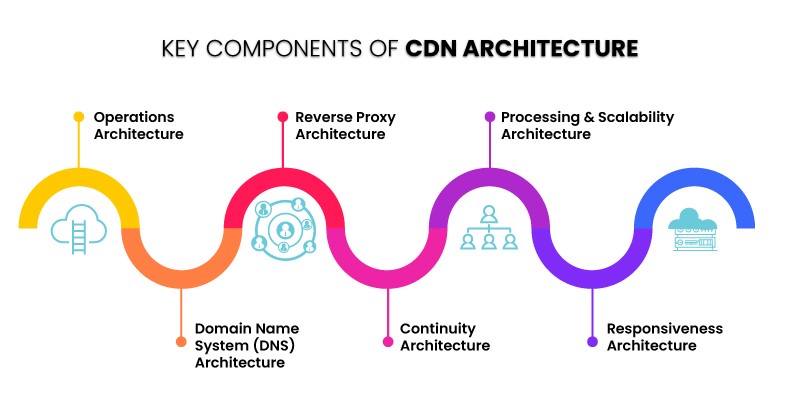BCS Stories
As of 2024, CDN services – More essential than ever

CDNs – Content Delivery Networks – are at the heart of the drive for excellent quality. CDNs were born as the internet grew up, originally designed to manage the movement of files between connected servers. A CDN created a managed pathway for the most efficient delivery of content over the internet. In essence the CDN was the “high occupancy vehicle lane” of the internet – allowing traffic to travel a faster route because it was managed to allow it.

As video streaming emerged, the HTTP technology that was built for fast file exchange was adapted to accommodate streaming video. For VOD, this was fairly straightforward as it built on similar “file transfer” concepts. For Live video, the challenges have been more fundamental as HTTP was not originally conceived for frequently updated, low latency video delivery. That said, latency and performance have reached very acceptable standards, largely matching the benchmarks set by satellite, cable and IPTV delivery methods. While public CDNs have been popular in the last ten years, the trend is now moving to private CDNs, that only improve performance and service control, but also manage costs more effectively.
Indian market dynamics
The Indian CDN market is estimated at was valued at Rs 6700 crore in 2023, expected with a 13.3 percent expected CAGR from 2023 to 2030.
The CDN market in India has been witnessing substantial growth, driven by the growing appetite for online content, increased digital media consumption, and the expansion of the e-commerce industry. Factors like improved internet connectivity, widespread smartphone usage, and the adoption of streaming services have played a significant role in boosting the demand for CDN services. Service providers in India cater to various sectors, such as media, entertainment, e-commerce, gaming, and education, offering solutions like content caching, video streaming optimization, website acceleration, security features, and load balancing to improve the delivery of online content to end-users.
Major players operating in the Indian market include Tata Communications Ltd., Amazon CloudFront – Amazon.com Inc., Akamai Technologies, Cachefly, CDNetworks Co., Ltd., CDNify Ltd., CDNsun, CDNvideo, CloudFlare, Inc., EdgeCast Networks, Fastly, Google Cloud CDN, Microsoft Azure CDN, Proinity LLC, Limelight Networks Inc., Skypark CDN, and Level 3 Communication Inc. Bharti Airtel, in partnership with Qwilt forayed into the CDN space and launched Edge CDN in September 2022.
There are 18 content delivery networks that have edge servers in one or more locations in India. 1 content delivery network provider has plans to launch a new POP in India.
CDNs in India
| CDN | POP Locations | Cities |
| Akamai | Unknown | unknown |
| BelugaCDN | 1 | Bengaluru |
| Bunny CDN | 4 | Bengaluru – Chennai – Mumbai – New Delhi |
| CacheFly | 1 | Mumbai |
| CDN77 | 1 | Mumbai |
| CDNetworks | 6 | Bengaluru – Chennai – Hyderabad – Mumbai – New Delhi – Patan |
| CDNvideo | 5 | Bengaluru – Chennai – Hyderabad – Mumbai – New Delhi |
| Cloudflare | 10 | Bengaluru – Bhubaneshwar – Chennai – Hyderabad – Kanpur – Kolkata – Mumbai – Nagpur – New Delhi – Patna |
| CloudFront | 6 | Bengaluru – Chennai- Hyderabad – Kolkata – Mumbai – New Delhi |
| EdgeNext | 5 | Bengaluru – Chennai – Hyderabad – Mumbai – New Delhi |
| Edgio | 4 | Bengaluru – Chennai – Mumbai – New Delhi |
| Fastly | 5 | Chennai – Hyderabad – Kolkata – Mumbai – New Delhi |
| Gcore | 1 | Mumbai |
| Imperva | 2 | New Delhi – Mumbai |
| Kingsoft Cloud | 1 | Bengaluru |
| Medianova | 0 | Mumbai |
| StackPath | 1 | Mumbai |
| Tata Communications | 6 | Bengaluru – Chennai – Hyderabad – Kolkata – Mumbai – New Delhi |
| Tencent Cloud | 5 | Bengaluru – Kolkata – Chennai – Mumbai – New Delhi |
Explained. CDN, is a network of servers distributed across a region to distribute internet content faster. Currently, most of the web traffic is served through CDNs, including traffic from sites such as Netflix, Facebook and Amazon. The Edge CDN will reduce latency, costs and load on servers, making it easier for OTT platforms to focus on app performance.
With a wide network of edge data centres, CDN is the next logical step for telcos to deploy. The number of devices is set to reach 50 Bn by 2025, per the Seagate report. Therefore, deploying a network of edge data centres allows them to deliver content faster and with low
As of 2024, India’s internet infrastructure and the ever-increasing demand for online services have made CDN services more essential than ever. From accelerating website load times to enhancing user experiences, CDNs have become a cornerstone of the internet ecosystem in India.





